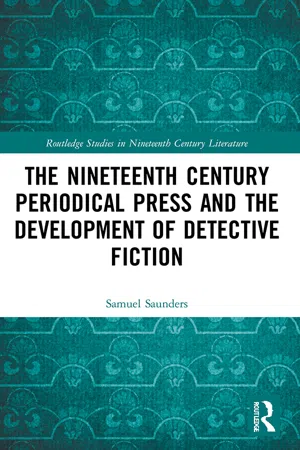Perhaps predictably, exploring ‘the police’ through mid-Victorian periodical discussion is a complex operation. As this book’s introduction discussed, any organised study of a broad range of mid-nineteenth-century periodicals has historically been difficult, and has necessitated the construction of careful methodologies with which to approach the enormous amount of primary material available. The growth of the press, coupled with the progression of social change (not in the least vast improvements in public literacy) also means that any study of periodicals must also necessarily link itself to the development of nineteenth-century society,7 as the boost the press experienced allowed it to embed itself as both a shaper and a reflector of public ideology. This complex connection between the press and society means that, while the press is a rich source of information on the police, it must be tempered by an effective methodological framework that organises the vast amounts of information, while simultaneously navigating the socio-political ideologies of journalists and publications themselves.
One way of doing this is through exploring the subject through different titles’ self-ascribed political leanings. In fact, this is a particularly relevant way of organising this part of the study, as both the police and the press shared a strong connection with contemporary politics. As Aled Jones argues, the diversification of the press in the mid-Victorian era was actually structured by newly-forged connections with contemporary politics, and the impressive variety of publications was actually constrained by ‘strict political limitations’.8 It was the moment of the repeal of the taxes on knowledge that had catalysed this politicisation of the press; as Stephen Koss summarises:
No sooner had legislative trammels been lifted from them than newspapers proudly affixed to themselves the labels Tory, Whig, or Radical, which broke down into such sub-categories as Peelite or Disraelian, Russellite or Palmerstonian, Cobdenite or Gladstonian.9
Given the extant connection between the press and politics, a relatively simple way of categorising titles by political allegiance is immediately appealing. However, it is also worth pointing out that it there are greater complexities that should be considered. Firstly, establishing exactly which publications can be ascribed which (or indeed any) political label is complex.10 As Martin Hewitt argues, many papers often had aims of their own and some were sustained by considerable political subsidy in exchange for open support.11 These back-alley antics obscured political motives, as it is often unclear whether periodical titles were offering their support for genuine ideological or for simply financial reasons. Indeed, some titles (particularly those who disagreed with this practice and others like it) became deliberately anti-political.12 Koss also notes that newspapers and periodicals occasionally amended their allegiances as the plate-tectonics of Victorian politics shifted, and publications became increasingly reluctant to flaunt their political alignment through fear of alienating potential readers – even more so when they were in receipt of party-related funds.13
Secondly, this kind of high-level categorisation cannot tell us much about readership, as it is virtually impossible to conclude exactly who read what, or whether the reader’s political views aligned in any way with what they were reading. Proof of a periodical’s purchase (itself hard to obtain on an individual level) also does not necessarily prove that it was read by the purchaser alone and, as Richard Altick suggests, this complicates the often-present narrative surrounding the class status of readers:
Whatever newspapers and other periodicals a household took in would, in the normal course of events, filter down to the servants’ quarters. In estimating the numbers of hands through which a given copy of a middle-class paper, or even a cheap book, might pass, one must not forget that the Victorian household contained not only a sizable family but also one or more servants with whom the paper wound up its travels.14
In fact, we should remember that proof of a magazine’s purchase does not necessarily prove that it was read by the purchaser at all. It may simply have been bought for someone else, or it could even have been immediately mislaid and forgotten about (perhaps unlikely, but nevertheless possible).
Thirdly, it almost goes without saying that ‘political’, or more accurately ‘partisan’, publications naturally did not constitute the entire press. Other, more ‘popular’ titles emerged that had interests other than politics some of which were quite specific. The lack of political interest on the part of some titles meant that these magazines often dealt with crime, policing, and punishment in different ways (though it should be noted that they could have just as strong an impact on the political sphere).15 The ‘popular’ press, which for the purposes of this chapter consists of largely non-partisan aligned magazines, is more difficult to organise and has a much murkier history, with some – such as Rosalind Crone – even suggesting there was not really a ‘popular press’ at all until after the repeal of the taxes on knowledge.16
Nevertheless, the way that Koss categorises periodicals according to politics is, at least, a useful initial approach to explore how the police were discussed in the mid-Victorian press. It sidesteps the issues surrounding readership by focusing on the target, rather than the actual, audience, and allows the chapter to explore how law enforcement was represented rather than how it was actually received. Again, Koss’s politically-driven model is also an especially relevant way to approach periodical commentary on the police, as criticism of the force was politicised particularly heavily. Openly partisan periodicals often used discussion of the police as a somewhat thin ...
